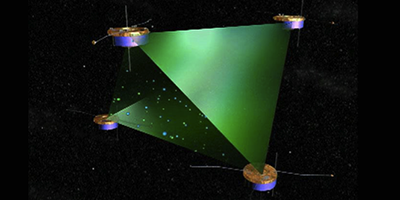The solar wind breaks through the Earth's magnetic field

Space is not empty. A wind of charged particles blows outwards from the Sun, carrying a magnetic field with it. Sometimes this solar wind can break through the Earth's magnetic field. Researchers at the Swedish Institute of Space Physics (IRF) in Uppsala now have an answer to one of the questions about how this actually occurs.
When two areas with plasma (electrically charged gas) and magnetic fields with different orientations collide, the magnetic fields can be "clipped off" and "reconnected" so that the topology of the magnetic field is changed. This magnetic reconnection can give energy to eruptions on the solar surface, it can change the energy from the solar wind so that it then creates aurora, and it is one of the obstacles to storing energy through processes in fusion reactors.
If two colliding regions of plasma have the same density, temperature and strength (but different orientation) of their magnetic fields, symmetrical reconnection begins. Scientists understand much about this process. But more usual in reality is that two regions of plasma have different characteristics, for example when the solar wind meets the environment round the Earth. Daniel Graham at IRF has recently published a detailed study of this asymmetrical magnetic reconnection in Physical Review Letters 112, 215004 (2014).The study uses data from the four European Space Agency satellites in the Cluster mission, satellites which fly in formation in the Earth's magnetic field.
"Especially important were measurments with two satellites only a few tens of kilometres from each other, in the region where the solar wind meets the Earth's magnetic field," says Daniel Graham. "We can thus do detailed measurements to understand plasma physics at a height of 60,000 km."
Heating of electrons parallel to the magnetic field in conjunction with magnetic reconnection is of especial interest.
"We believe that this is an important piece of the puzzle for understanding how magnetic reconnection works, how charged particles are accelerated, and how particles from different regions can be mixed with each other," says Daniel Graham. "Our detailed measurements in the Earth's magnetic field can be used to understand the physics even in fusion reactors on Earth, and in far distant regions in space that we can't reach with satellites."
More information:
D. B. Graham, Yu. V. Khotyaintsev, A. Vaivads, M. André, and A. N. Fazakerley Electron Dynamics in the Diffusion Region of an Asymmetric Magnetic Reconnection
Phys. Rev. Lett. 112, 215004 – Published 28 May 2014. journals.aps.org/prl/abstract/ … ysRevLett.112.215004
Journal information: Physical Review Letters
Provided by Swedish Institute of Space Physics





















